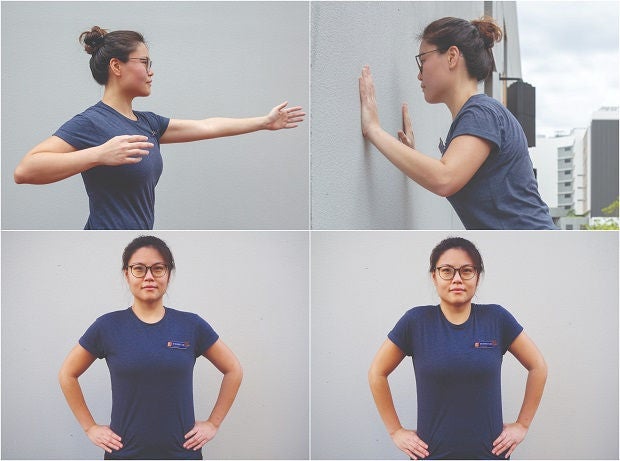
Dr Bernice Liu, Principal Physiotherapist at Sengkang General Hospital, demonstrates basic workout moves, such as trunk rotation, wall push-ups and shoulder shrugs, that can be done at home.
Gyms, sports complexes and yoga studios have shuttered, and many have had to work from home due to “circuit breaker” measures that were put in place to mitigate the spread of COVID-19. This has inadvertently led to people clocking fewer hours of exercise and physical activity each day.
“Even before the COVID-19 pandemic happened, a World Health Organization (WHO) study noted that nearly 40 per cent of Singaporean adults are not getting enough physical activity,” said Dr Bernice Liu, Principal Physiotherapist, Sengkang General Hospital (SKH).
Home workout
Exercise is important because it lowers the rates of mortality, coronary heart disease, high blood pressure, stroke, type 2 diabetes, colon and breast cancer, as well as depression. It also helps maintain a healthier body mass and composition, said Dr Liu.
In a world upended by COVID-19, “many people are also coping with fear, anxiety, stress, financial concerns, sadness, boredom, and isolation — all of which can have a negative effect on their diet, physical health, and mental well-being. Sedentarism may further worsen the situation, especially for those with depression or cognitive disorders”, said Dr Fadzil Hamzah, Senior Staff Registrar, Sport and Exercise Medicine, Changi General Hospital (CGH).
In fact, 150 minutes of moderate-intensity exercise or 75 minutes of high-intensity exercise is recommended per week. In addition to health benefits, regular exercise also helps reduce stress, releases endorphins for a mood-boosting effect, and promotes better sleep.
It is not difficult to incorporate physical activity into your daily routine at home. Any clutter-free space approximately two by two metres big can be transformed into an exercise station. Simple workout ideas include jogging on the spot or calisthenic exercises, such as push-ups, planking, and squats. For the elderly, Dr Liu recommends wall push-ups, shoulder shrugs, trunk rotation exercises, or sitting and standing from a sturdy chair of standard height in three sets of 10 to 15 repetitions.
Finding motivation
“Exercise need not necessarily be associated with workouts in gyms, exercise studios, or sports activities. There are also recreational activities that can help raise your heart rate sufficiently. If the word ‘exercise’ does not inspire you, try starting with an activity you enjoy. It could be standing up while singing karaoke, dancing along to music, or even doing spring cleaning,” suggested Ms Chitra Chandran, Senior Physiotherapist, Sengkang Community Hospital (SKCH).
To keep young children engaged, activities like hopscotch and jumping on the trampoline can help. For those who are more adventurous, Dr Liu suggests improvising a balance beam by marking lines on the floor with masking tape, or creating an obstacle course with furniture. This way, an element of fun is added to the exercise regime.
Another way to reap more benefits from your workout is to practise mindfulness. “Let go of distractions and unrelated thoughts, and focus your attention on how your body feels, your breathing, and the movements of your body during the workout. This helps relieve stress and reduce the risks of training injuries,” said Dr Fadzil.
Embarking on a new workout regime may be the silver lining during this period, when more people seek to cultivate a positive habit of keeping active, even at home. Previously, the lack of time has always been one of the most common reasons people have been unable to incorporate physical activity into their busy lives. “It takes consistent effort and repetition for a behaviour to become a habit, and in turn, this will lead to a lifestyle change. Hopefully, with more flexibility of time, more people can adopt regular exercise sessions and continue with this healthier and more active lifestyle,” Dr Liu said.
Safety rules
A few basic precautions will enhance the safety of home-based workouts.
1. Listen to your body
If you are new to exercise, start slow. Do not push yourself if you experience extreme shortness of breath and/or extreme fatigue, giddiness, or pain.
2. Watch your posture
Exercising with poor form, such as slouching, can lead to injuries and strains.
3. Put on proper footwear
Sport shoes can provide a good non-slip surface, adequate shock absorption, and ankle or foot support for high-impact activities, such as jogging or jumping. Be sure to don proper footwear that is suited for the intensity of your workout. It is also important to wash your shoes regularly, so that you do not bring germs and bacteria into your home.













 Get it on Google Play
Get it on Google Play